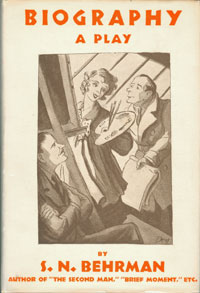|
 |
Biography
S. N. Behrman
New York:
Farrar & Rinehart, 1933
First edition in dust jacket
Inscribed by Behrman |
| |
|
(On front free endpaper)
For Bill Couselman, / My neighbor in
art! / Sam Behrman / Westwood. Cal. / Feb. 1933. |
|
|
Biography, which Theatre Guild producer
Lawrence Langner rated as "the best comedy the Guild ever
produced," represents Behrman at an all-time high, a
supremely successful example of collaborative theatre art,
thanks in large measure to its star, Ina Claire. In
Biography, the earliest, most fully developed of
Behrmanís emancipated women, Marion Froude Ė a portraitist
of minor artistic distinction and a woman of major
laissez-faire morality Ė finds herself, by virtue of
painter-subject association with her provocative
celebrities, the focus of interest by a weekly periodical
that proposes to feature her biography if she will only
write it. Attracted equally by this literary challenge as by
the brash, brooding, and surly editor, Richard Kurt, Marion
agrees. Her positive action results in bringing previous
lovers into her immediate presence, one of whom, a
conservative candidate for senator from Tennessee, fervently
hopes not to be included in the memoirs (lest
guilt-by-association prove politically and matrimonially
damaging); while another, a fading Hollywood star,
desperately desires inclusion hoping thereby to bolster his
flagging career. The dilemma becomes further complicated by
Marionís affair with her editor, an association which clouds
her usually clearheaded perceptions. Marionís biography, "a
mental spring housecleaning," while providing a healthy
purgative for the authoress, ultimately blazes in the
fireplace of her West 57th Street atelier, and Marionís
business-personal relationship with Richard burns with it.
Characterization in this play is dense, complex, and rich.
Few, if any, would recognize the inspiration of Marion
Froude and Richard Kurt in the Hollywood personalities of
Ann Sheridan and Oscar Levant. An unpublished doctoral
thesis traces Marionís ancestry to prima donna Grace Moore,
illustrator Neysa McMein, and English actress Ellen Terry.
Since first viewing her, as a junior at Harvard from a
distant second-balcony seat, Behrman spent the next
seventeen years in pursuit of Ina Claireís non plus ultra
comedy talent before achieving his objective. Thereafter he
conceived most of his leading female characters as if Claire
were to illumine them onstage. (As late as the early 1960s,
the manuscript of But For Whom Charlie describes
Gilianís entrance in these terms: "She is radiantly lovely Ė
Ina Claire at fifty." In 1953, when the possibility of
adapting Serena Blandish to the musical stage
presented itself, Behrman voiced his approval of Dolores
Grey for the role of the Countess because she looked "Ina
Clairish.") For all of her other character studies
(including one from the pen of poet T.S. Eliot), Claire
remains fixed in the mind of the theatregoer for her
interpretation of two of Behrmanís heroines, Marion in
Biography and Leonie in End of Summer. Behrman
and Claire: their different theatrical talents complemented
each other perfectly. |
|